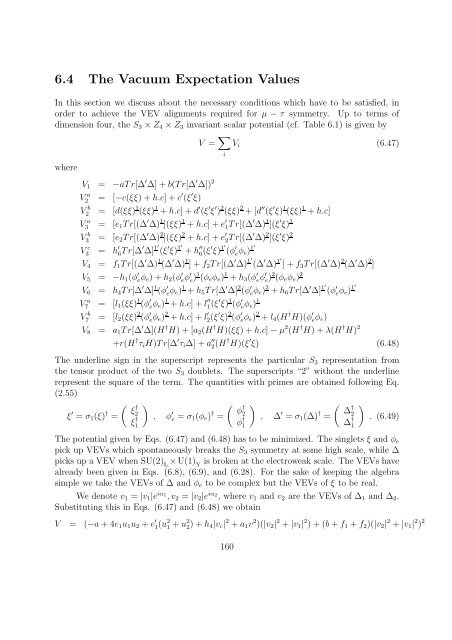PHYS08200604017 Manimala Mitra - Homi Bhabha National Institute
PHYS08200604017 Manimala Mitra - Homi Bhabha National Institute
PHYS08200604017 Manimala Mitra - Homi Bhabha National Institute
Create successful ePaper yourself
Turn your PDF publications into a flip-book with our unique Google optimized e-Paper software.
6.4 The Vacuum Expectation Values<br />
In this section we discuss about the necessary conditions which have to be satisfied, in<br />
order to achieve the VEV alignments required for µ − τ symmetry. Up to terms of<br />
dimension four, the S 3 ×Z 4 ×Z 3 invariant scalar potential (cf. Table 6.1) is given by<br />
V = ∑ i<br />
V i (6.47)<br />
where<br />
V 1 = −aTr[∆ ′ ∆]+b(Tr[∆ ′ ∆]) 2<br />
V2 a = [−c(ξξ)+h.c]+c ′ (ξ ′ ξ)<br />
V2 b = [d(ξξ) 1 (ξξ) 1 +h.c]+d ′ (ξ ′ ξ ′ ) 2 (ξξ) 2 +[d ′′ (ξ ′ ξ) 1 (ξξ) 1 +h.c]<br />
V3 a = [e 1 Tr[(∆ ′ ∆) 1 ](ξξ) 1 +h.c]+e ′ 1 Tr[(∆′ ∆) 1 ](ξ ′ ξ) 1<br />
V3 b = [e 2 Tr[(∆ ′ ∆) 2 ](ξξ) 2 +h.c]+e ′ 2Tr[(∆ ′ ∆) 2 ](ξ ′ ξ) 2<br />
V3 c = h ′ 6 Tr[∆′ ∆] 1′ (ξ ′ ξ) 1′ +h ′′<br />
6 (ξ′ ξ) 1′ (φ ′ e φ e) 1′<br />
V 4 = f 1 Tr[(∆ ′ ∆) 1 (∆ ′ ∆) 1 ]+f 2 Tr[(∆ ′ ∆) 1′ (∆ ′ ∆) 1′ ]+f 3 Tr[(∆ ′ ∆) 2 (∆ ′ ∆) 2 ]<br />
V 5 = −h 1 (φ ′ eφ e )+h 2 (φ ′ eφ ′ e) 1 (φ e φ e ) 1 +h 3 (φ ′ eφ ′ e) 2 (φ e φ e ) 2<br />
V 6 = h 4 Tr[∆ ′ ∆] 1 (φ ′ e φ e) 1 +h 5 Tr[∆ ′ ∆] 2 (φ ′ e φ e) 2 +h 6 Tr[∆ ′ ∆] 1′ (φ ′ e φ e) 1′<br />
V a<br />
7 = [l 1 (ξξ) 1 (φ ′ e φ e) 1 +h.c]+l ′′<br />
1 (ξ′ ξ) 1 (φ ′ e φ e) 1<br />
V b<br />
7 = [l 2 (ξξ) 2 (φ ′ eφ e ) 2 +h.c]+l ′ 2(ξ ′ ξ) 2 (φ ′ eφ e ) 2 +l 4 (H † H)(φ ′ eφ e )<br />
V 8 = a 1 Tr[∆ ′ ∆](H † H)+[a 2 (H † H)(ξξ)+h.c]−µ 2 (H † H)+λ(H † H) 2<br />
+r(H † τ i H)Tr[∆ ′ τ i ∆]+a ′′<br />
2 (H† H)(ξ ′ ξ) (6.48)<br />
The underline sign in the superscript represents the particular S 3 representation from<br />
the tensor product of the two S 3 doublets. The superscripts “2” without the underline<br />
represent the square of the term. The quantities with primes are obtained following Eq.<br />
(2.55)<br />
ξ ′ = σ 1 (ξ) † =<br />
(<br />
ξ<br />
†<br />
2<br />
ξ † 1<br />
)<br />
, φ ′ e = σ 1 (φ e ) † =<br />
(<br />
φ<br />
†<br />
2<br />
φ † 1<br />
)<br />
, ∆ ′ = σ 1 (∆) † =<br />
(<br />
∆<br />
†<br />
2<br />
∆ † 1<br />
)<br />
. (6.49)<br />
The potential given by Eqs. (6.47) and (6.48) has to be minimized. The singlets ξ and φ e<br />
pick up VEVs which spontaneously breaks the S 3 symmetry at some high scale, while ∆<br />
picks up a VEV when SU(2) L<br />
×U(1) Y<br />
is broken at the electroweak scale. The VEVs have<br />
already been given in Eqs. (6.8), (6.9), and (6.28). For the sake of keeping the algebra<br />
simple we take the VEVs of ∆ and φ e to be complex but the VEVs of ξ to be real.<br />
We denote v 1 = |v 1 |e iα 1<br />
,v 2 = |v 2 |e iα 2<br />
, where v 1 and v 2 are the VEVs of ∆ 1 and ∆ 2 .<br />
Substituting this in Eqs. (6.47) and (6.48) we obtain<br />
V = (−a+4e 1 u 1 u 2 +e ′ 1 (u2 1 +u2 2 )+h 4|v c | 2 +a 1 v 2 )(|v 2 | 2 +|v 1 | 2 )+(b+f 1 +f 2 )(|v 2 | 2 +|v 1 | 2 ) 2<br />
160
















